경기문화재단
Architects Creating Living Culture
Gwanyang-dong, Anyang Spunky El Design Lab Yun Gyeong-suk and Cha Ju-hyeop
Recently, we can easily see various cultural and arts projects taking part in community activities by modifying abandoned, forgotten places in a city or a village. In this case, architecture and architects stick closely to each other almost like being in a cause and effect relationship. In order for artists, cultural directors, and local residents to convert a drowsy place which has been neglected for a long time into valuable space, they should repair or rebuild buildings first and then plan cultural arts activities based on the new architectural environment. However, you cannot easily meet those architects once the regenerated place opens. Here, there are architects who like hanging out with their neighbors. In an alley in Gwanyang-dong, Anyang, where apartments and multi-household houses are gathered, Spunky El Design Lab is situated on the first floor. Its office has a floor to ceiling glass window like a stationery store, so passers-by can easily peer inside. In this office, I met Spunky El Design Lab Co-Heads Yun Gyeong-suk and Cha Ju-hyeop. As its name, “Spunky El,” short for Spunky Elephant, their conversations were full of imaginations and energy.

Spunky El Design Lab Office and Co-Heads Yun Gyeong-suk and Cha Ju-hyeop. The table is placed right next to the floor to ceiling glass window so they can observe the alley and make eye contact with passers-by during their conversations.
Cultural and Artistic Events of Life What Architects Want to Make
Spunky El Design Lab reinterprets and newly defines living space through architecture, interior design, urban research, exhibition planning, etc. Based on our new interpretations through analyses and research on living space, we make creative architectural suggestions. We hope our lives will become more affluent in the space.
– Introduction of Spunky El Design Lab from its blog
Q : It is difficult to meet architects who participate in local cultural activities. I think architecture is really important as it deals with huge urban planning projects such as the redevelopment of undeveloped regions and renovation of unused space. Besides, architecture builds a foundation for human activities. On the other hand, it feels like architects are hiding behind the walls or in the rooms. However Spunky El Design Lab is situated on the first floor, which is very visible. (laughter) What made the architects focus on the communities or “villages”?
(Cha Ju-hyeop, hereinafter referred to as Cha) You cannot easily find architects on the first floor. The reason being, it’s expensive. We were only looking for the first floor though. (laughter) (Yun Gyeong-suk and Yi Ha-yun) The first floor is important. Passers-by say, “Spunky El? What is it?” They wonder what we are and some kids come and see our sign. That’s how we get close to our neighbors. Cha I hope we can get closer to our neighbors in some place like a market where numerous people walk around and some events are held. Yun I used to work for a company, but I decided to quit my job and founded Spunky El Design Lab. Because of our Anyang old town exploration project we have been working on since 2012, it seems like we have been working here for a long time, but we have just started. At that time, we didn’t have any goals like cultural planning. It was by chance. When I took a break after quitting my job in Seoul, I started thinking about my town, what kind of city Anyang is. I have lived in Anyang since I was a kid, so I’m kind of attached to this city. I felt so weird when I heard that Deokcheon Village, one of the oldest villages in Anyang, would completely disappear. So I decided to explore the village before it disappears. That is why we started exploring old towns and we have been recording Anyang’s own characteristics distinguished from Seoul. Naturally, I became interested in other regions as well.
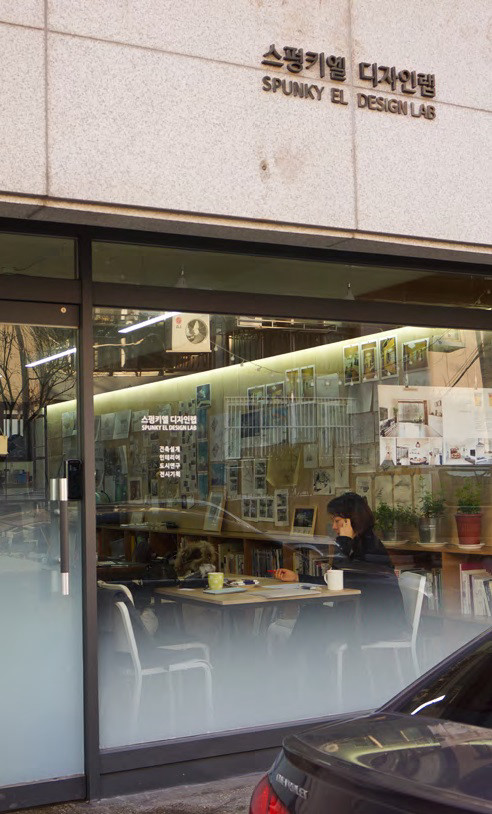
The table is placed right next to the floor to ceiling glass window so they can observe the alley and make eye contact with passers-by during their conversations
City/Village Explorations Where Two Different Perspectives Interact with Each Other
Q : Before I met you today, I saw your blog. It seems like you guys think that explorations show your attitude as architects and form a foundation for almost all activities. Seoul has a long history as a capital with a history of hundreds of years, but Anyang is a relatively young city. Isn’t it difficult to find attractive places to explore in Anyang?
Yun When I first started old town explorations, I read a lot of books about housing and history. But most of the records focused on Seoul. Buildings in Anyang are distinguished from buildings in Seoul. In particular, Deokcheon Village was the place where labor workers settled down in the 1960s and 1970s. So, I could find a variety of house styles between hanoks (traditional Korean style houses) and apartments. It was like a museum of modern residential architecture.
Q : I think that team members who participated in explorations have different personalities and backgrounds. How did you conduct the explorations?
Yun We usually check and decide on the route first, and look around a village with someone who is very knowledgeable about the village. As there are not many records about the villages in Anyang, we run into verification issues. So, we consider all records as personal records.
Cha Once we conducted an exploration under the theme of trees. In new towns, green space just surrounds buildings, is blocked by barricades, or is merely for design. I thinking urban planning projects all failed thus far. The important thing goes into the strategy of building and the will of land owners. If you want to build something, you do it in one way or another. If you don’t have any green space, you can put dozens of rubber flower pots in your garden. During my explorations, I realized that architects were arrogant and superficial. I reflected on my past performances.
Architects Who Want to Enjoy Community Culture with an Open Mind
Q : Generally, it is difficult for people to meet with architects whereas they can easily meet with realtors and interior designers. Is your goal to become “community architects”?
Cha Architectural activities are so much more than just building houses. If you want to make a door on this wall, you have to figure out if it is possible and what shape you want. We can think about such small issues together. It’s part of our job.
Yun It was not a goal but reality. At first, right after we needed to find an office, we didn’t have much money and had to save time. So, we settled down here because it was cheap and close to our places. In addition, I’m a “person who wants to enjoy culture and arts on my own.” Before we opened this office, we had started a gallery coffee shop under the same name in 2012. We worked at te coffee shop and held some exhibitions. So we were able to make personal connections with artists and sold their artworks. Our regular customers would bring their friends and show them the coffee shop saying, “My town has such a nice gallery coffee shop!” If paintings do not change over a long period of time, some regulars ask us why. I like enjoying arts together with others. Our cultural needs were huge but we couldn’t easily find a place to enjoy them. So, we built our own platform. Through Cafe Spunky El, we could enjoy culture and arts in the village and saw our potential as community architects.
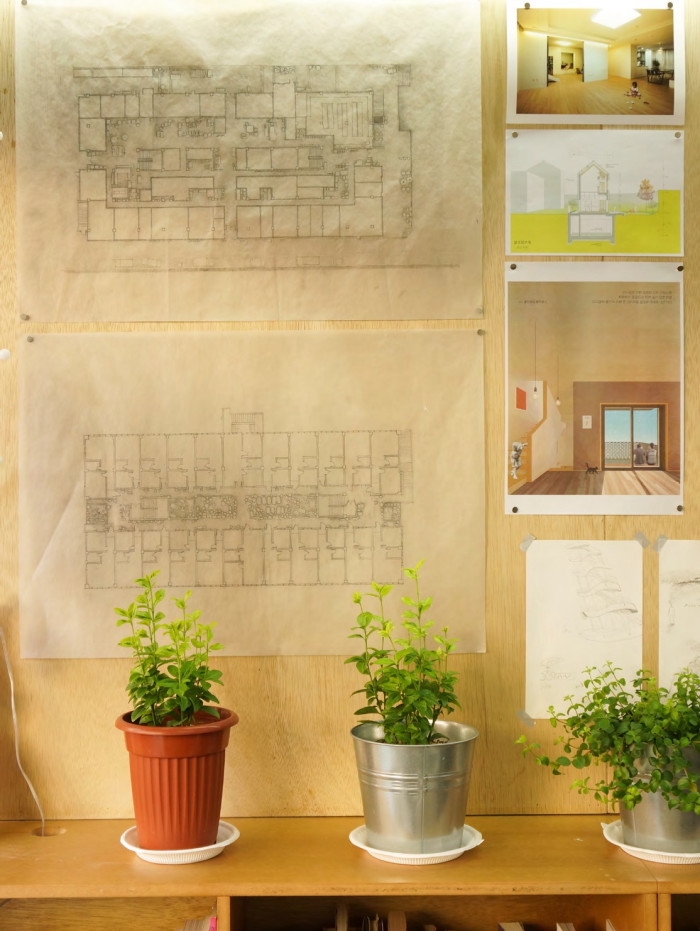
The floor plan of a building in Myeonghak Market drawn during the “Recharging Battery Alley” project is hung on the wall of the office. “Recharging Battery Alley” was a project to meet people in the city where garages, karaokes, bars, and small libraries coexisted, shared the stories about their lives, houses, and trees, find and draw alleys, and find things to read and think about.
This Town, Our Architectural Issues
Q : How can you build a community as architects? Who are “Us” exactly in architecture (architects)? Of course, you may oppose the uniform definition of communities, “Us.”
Yun I’m an architect, but I love arts, movies, and cartoons. Everyone has different interests. Even though we do not share the same things together, we can become “Us” at the point where our varied interests intersect with each other. If you want to build a community based on such intersections, we need to spend time together. Does somebody pay us for such activities? No. After the lapse of time, I realized that we had a strong community already.
Q : What kind of architectural issues did you find in “Us”?
Yun Issues? There are a lot of issues!
Cha Cars that parked on the streets. That corner. These things are all architectural issues. As a 30-year-old building contains the culture of the time, they wouldn’t know it would change a lot.
Cha What I worry about the most in this city, Anyang, is uniformity. Deokcheon Village disappeared and became apartment complexes. Some large parcels of land that have already been sold in Anyang will all become apartment complexes. Now, we can no longer find the particular lifestyles of old towns we saw during our explorations. I wonder if children growing up in those apartments can understand that people from all walks of life are living in the city and can get along with each other. I grew up in this village. When I was a kid, some friends were living in detached residences, some were living in leased single rooms, and some rich friends were living in apartments. That was my understanding of a community as I was growing up. It’s not their fault that they can only see uniform residential space. But, we, architects, should ponder over how we should express diversity among the uniformity.
Q : I guess architects are not the only one who should pay attention to the architectural issues of communities. What would you like to suggest for a community to do in order to involve architecture (architects) in?
Yun I hope people realize that house repairs will likely vary greatly among architects. I think it would be great if people find the right architect for them and change their own space, instead of just pointing out the issues.
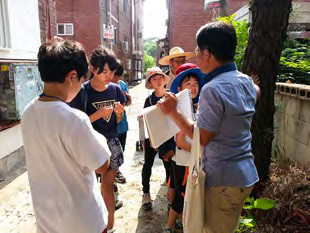
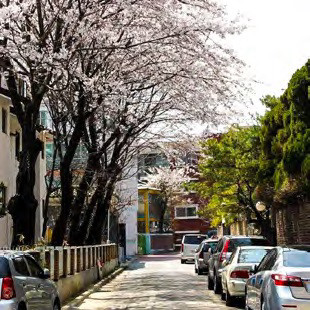
Photos taken during the project, “Play on the Streets!” “Play on the Streets!” held in Gwanyang-dong was a project in which local residents including children visited a city with artists and ecologists to learn about trees and imagine playgrounds and villages. In addition to rattan they can easily see in their villages, they learned that there were a wide range of trees including bee-bee trees, torulosa, ailanthus loved by spotted lanternflies, Carolina polar, Chinese parasol trees, Kobus magnolia, white pines, trident maple, Japanese red maple, Japanese maple, dawn redwood known to have been living since the Triassic period, five-needle pines from Ulleungdo Island, and tulip trees. In addition, they discovered and reflected on the fact that some trees were killed or deformed by local residents.
Play in the Alley, Play in the Playground, Play in the City
Q : I think most of the participants of “Play on the Streets!” were children and you focused on the observation of the village landscape, place/map reading and making, and learning about ecology/nature. What was your goal with the combination of the three activities?
Yun After I walked around outside of buildings in the city, I realized that there were a plenty of interesting things there. But, people just stay inside, like watching TV. I wanted to find some activities you could do outside of buildings, by walking around the alleys. And, wouldn’t it be much better and interesting if it were done with artists?
Cha Kids cafes. Karaokes and Korean spas. In fact, Korea has a very advanced culture of space. In New York where Yun used to live, people can run into a lot of events to enjoy the city. You can find a gallery one block away from your place and museums and parks are everywhere. The parks provide a wide range of programs. But we cannot find such things in the city we are living in now. Maybe in Seoul? How many playgrounds are there in Gwanyang-dong? A lot. But they are not used. You cannot find kids at the playgrounds.
Yun We call these playgrounds built in the small sites “pocket playgrounds” and marked them as red dots on the map. They must have been designated as playgrounds in the urban plans, but they were just empty sites. Except for Daboram Playground, all the playgrounds were filled with readymade playground equipment.
Cha The structures and locations of the playgrounds were problematic as well. Playgrounds are surrounded by illegally parked cars. In addition, trees are planted too densely so you cannot even see the inside of the park. There is no ideal playground where you have a broad view of the inside of the park. Yun I hope parents listen to their children about what kind of playground they want to play in. Based on such imaginations, I would like to ponder over, discuss, and talk about the village we want to live in.
Q : I hope some of the children think, “20 years later, I will change the playgrounds in this village.”
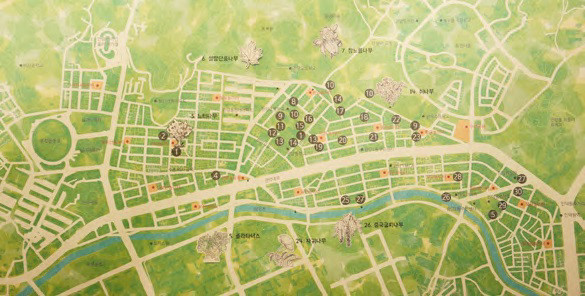
Gwanyang-dong Playground Map made during the “Play on the Streets!” project. They said there are dozens of similar playgrounds in small villages.
Recharging Together in the Alleys
The culture & arts group “Golmokgil” is a gathering of artists. Based on their affection for the city and urban research, they try to revitalize the disappearing alley culture and connect neighbors through culture and arts.
- Introduction of Golmokgil
Q : I think you could carry out the “Play on the Streets!” project thanks to the support from other directors and artists. What do you think are the reasons you can work together like this? If you work as a team, someone must take care of some work no one wants to do. Were there any difficulties?
Yun Our group’s name is “Golmokgil” which means alleys. Most of the participating artists were our friends in the neighborhood. Jang Hyeong-sun (papercraft artist), Kim Joon (photographer), Im Jin-se (photographer), and Kim Dong-min (artist) are all local artists. We met Kim Hak-song who is a tree expert during the “Recharging Battery Alley” project and he helped us for “Play on the Streets!” as well. I just made a plan and the participating artists did everything. As we had explored old towns together before, it was not difficult to conduct the project together. One of my friends in the neighborhood took care of the publicity, so we could gather participants easily. People are the most important aspect in everything. We were already close to one another before the “Play on the Streets!” project began, so we were able to have a lot of fun in the alleys. It was a project supported by public organizations, so all the settlement and payment processes were the most difficult part.
Cha I think someone has to fire things up. If he/she says it’s going to be interesting, other people join him/her.
Yun In fact, it’s painful. We don’t want to produce some unprofessional results. I think whatever we do, we should develop it ourselves. I want to think, “It might be difficult, but it will make us learn something,” rather than “I like doing this with these guys.” I want to believe that the end point will be different from the starting point
People I met in the Alleys
Q : Which village was the background of the “Recharging Battery Alley”? Isn’t it the one with a lot of garages and karaokes? I wonder how local residents reacted.
Yun It was a very small village and a small library named “Beyond the Stories” led the project. It used to be called “Battery Alley,” but the garages all disappeared and it’s now called “Ba Alley.” Isn’t it interesting that there is a library in such a village? You can learn a lot of things about a village by interviewing the local residents. I really respect Beyond the Stories that focuses on recording oral history and records the lives of normal people. At the opening of the exhibition, physically handicapped children learning the violin at Beyond the Stories and their parents held a small concert. I was happy when local residents said, “I didn’t know our village has such stories.” or “I know him. He’s lives next door to me.”
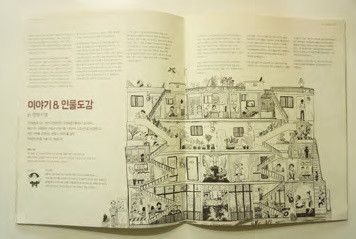
Myeonghak Market Painting in the Recharging Battery Alley Exhibition brochure, drawn by Jeon Ji
Recently, Spunky El Design Lab has been spending a lot of time working on the projects related to “houses.” They are working on remodeling the interior space of an apartment for a family consisting of working parents in their mid-40s, a child going to preschool, and the child’s paternal grandmother, with the project name “Circulating House.” They named the project to build a detached residence for a young couple, a kid, and a grandmother “Warm House.” I could see other sketches showing their thoughts about relationships between space and humans, behind the model of “Warm House.”
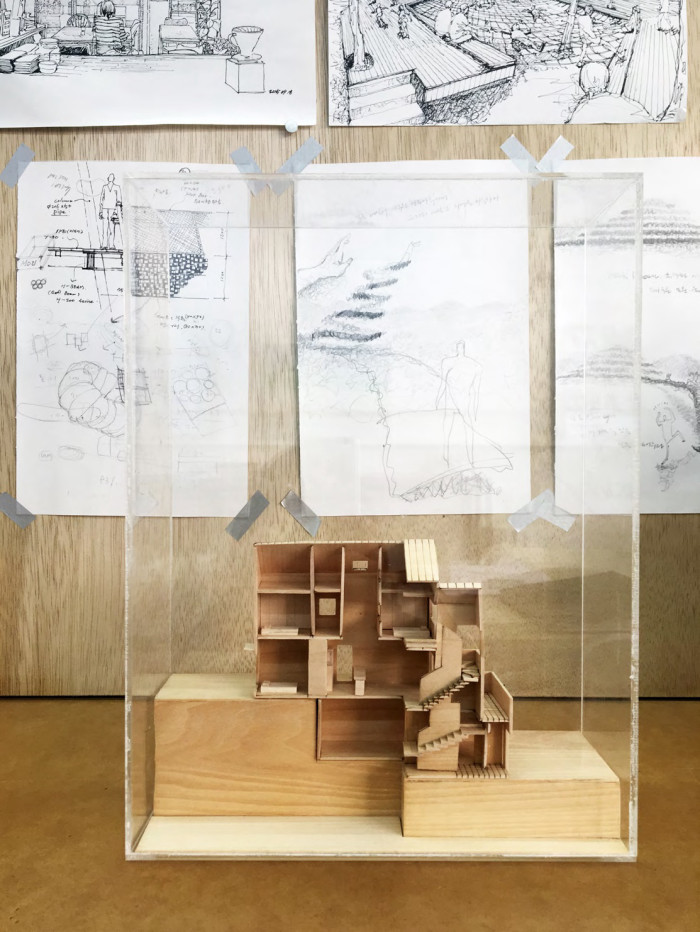
Community Yard to Revisit
Q : Through the “Recharging Battery Alley” project, you sought for joint movements to be able to focus on the environment, ecology, and lifestyles of a village which was depressed in terms of both the economy and community. How did you find Myeonghak Market which was the main background of your project?
Cha Myeonghak Market is one of the treasures we found in Anyang. Having a book club meeting with local residents and visiting the village, we found this very interesting building, Myeonghak Market. Myeonghak Market is a multipurpose building. There is a yard in front of the gate of the third floor of the apartment. In the front yard, people make Korean soy sauce and kimchi and grow plants. It was built in the 1980s. If we have a chance to build an apartment or a multi-unit building in the future, we will design it like Myeonghak Market. In the 1980s, people thought a house should have a yard. That thought was incorporated into the apartment. In present-day apartments, you are disconnected from your next door neighbor. If you open the door, you cannot see a yard nor do you have any chance to find out who is living next door to you. If we had a community yard and some community events were always held in our apartment, we would have a totally different community from now.
Yun It’s ironic. The residential environment focusing on the community changed to the residential environment where a community can be hardly formed. Now we are investing a lot of money and efforts to build a community again. One of the worst cases in new city planning is to disconnect houses from other space. Some places are full of private educational institutes or restaurants and some places were blocked by fences. Looking at such places, I imagine tearing down there, building a street, converting the lower floors into stores, and removing the upper floors!
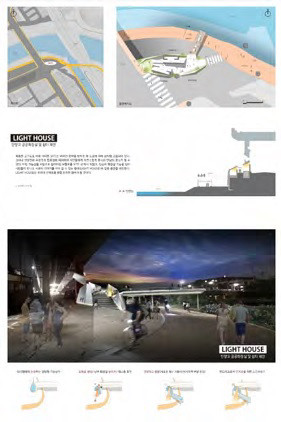
Architects imagine and plan new space in advance. In many cases, architects should take a long time to ponder over a design and its implementation when making an architectural plan considering a city or public space. Spunky El Design Lab suggested public restrooms and rest areas near Anyanggyo Bridge. Architect’s suggestions bring up a conversation topic in a community, only with planning.
The Future Architects Want
Q : I think you worked as more like cultural directors in your previous project, but now you seem to be trying to become involved in the cultural and social issues of a community as “architects” under the name of Spunky El Design Lab.
Yun I hope that architects will make more efforts to improve the quality of the lives of our neighbors, friends, the commonalty, and people in the middle class, instead of working for the top one percent of our society. The important thing is that architecture, regardless of personal residences or public buildings, should keep making small changes in your life and make you realize the differences, instead of simply making your life more convenient.
Cha We should find solutions to architectural issues around us. I think I wouldn’t have liked it in the past, but now I am okay if someone calls me a community architect. I hope we can create an environment where we can think about architectural issues together with others.
Yun There is this project we really want to do but we couldn’t even start it yet. It’s called “House Autobiography.” People write their autobiographies, usually focusing on their achievements. I believe that you can talk about your entire life story focusing on the houses. You can reflect on yourself while focusing on the past houses and recall memories relating to those spaces. You can write autobiographies of normal people. In the past, we all went home. To your friend’s place. To someone’s place. If someone visits your place, you will naturally decorate your house. Regardless of the house size, some people are good at expressing their personalities in their houses. The houses embody who they are. I want to record our stories and memories about houses.
Q : As architects, what do you think about future bonds?
Cha Bonds like offline relationships are disappearing little by little. Everyone is looking at their smartphones. On the contrary, by looking at your smartphone, lots of things may be solved. In the future, bonds may be a totally different thing or on a different level you cannot even imagine now. Is it too cartoony?
Yun You went too far. (laughter)
Q : It’s architect’s imaginations. It’s engineering. (laughter)
Yun Interactions between different people form bonds and such bonds create other bonds intersecting with each other. I think we need a platform where such bonds can be formed.
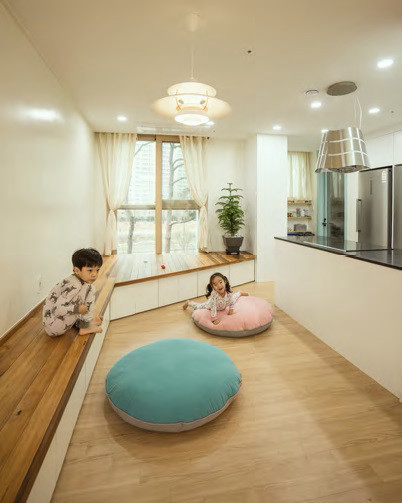
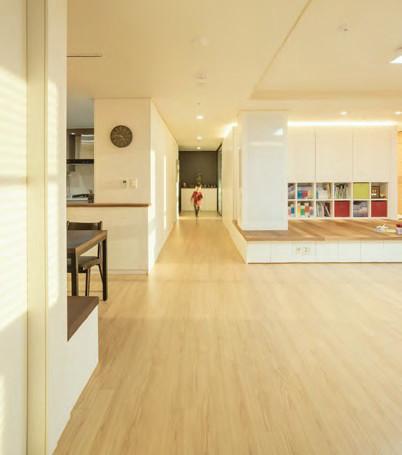
Images of the architectural projects of Spunky El Design Lab that builds life events at you and your neighbors’ houses in the village. “House Growing with Kids” (top, middle) and “Circulating House” (right)
<ggc의 모든 콘텐츠는 저작권법의 보호를 받습니다.>